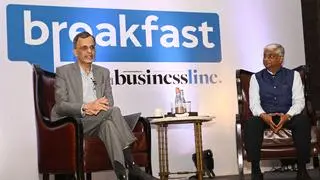In the high-pitched debate on cardiac stents and its pricing, one voice is barely audible. That of the Indian stent-maker.
With 13 members on board, the Indian Association of Medical Stents Manufacturers (IAMSM) has not made public its views on the price control slapped on stents by the National Pharmaceutical Pricing Authority (NPPA). Nor have they vocally contested the perception that Indian stents do not make the quality cut, oft heard in medical and industry circles.
Ganesh Sabat is Chief Executive of SMT or Gujarat-based Sahajanand Medical Technologies, touted to be the country’s largest domestic stent maker. Also wearing the hat as IAMSM President, Sabat gives us a rarely seen view from the other side of the stent divide.
Domestic stent makers are not unhappy with the NPPA's decision as the average price realisation to the company (without distributor margins) remains unaffected, says Sabat. Besides, he adds, local manufacturers have always operated on low marketing expenditures.
Supply chain
“The multinationals find it unviable not because of the products but because their business models are not viable,” exclaims Sabat, responding to complaints that price control was making business unviable. Foreign companies do not invest in the supply chain and they depend on distributors, he explains. “We do not supply through distributors and supply directly to the hospital,” says Sabat.
Cardiac stents are wire-like meshes used to unblock clogged blood vessels. And before they were brought under price control, cardiac stents were pushed at exorbitant margins to the distributors and hospitals. And this bulked up the final price that patients had to pay on a stent.
Under price control now, trade margins are pegged at 8 per cent. And stent prices are down to about ₹7,600 on bare metal stents and over ₹30,000 on drug-eluting stents. A steep crash from the ₹25,000 to ₹2 lakh-odd forked out earlier by patients for a stent.
Quality questions
With manufacturers of various hues dabbling in medical devices and imports, the worry for patients is whether indeed ‘all drug-eluting stents are equal’, an observation the Centre made before cracking down on prices.
If a product has been approved by the Drug Controller General of India (DCGI) for sale in the country, the assumption is that it is a safe and quality product, says Sabat. And then again, there is no fool-proof regulatory system, he says, citing the example of foreign-made stents like Cypher that faced patient law suits overseas.
The DCGI needs to consider one year’s follow up data from companies before they launch a stent, he suggests. If there has been no adverse event in that time, then there’s more than 90 per cent chance you have a good product, he says. It will be even better if the DCGI takes three or five years follow up data, he adds.
Countering the quality perception and questions of his company’s lineage in making diamond cutting equipment which critics say is different from the engineering that goes into a stent, Sabat says they have proved the efficacy of their products with long term data in Europe. Taking the battle to the competitor, he says, details from another international trial comparing their product to Abbott's Xience, the market leader, is scheduled to come out in June.
SMT may have stepped up to scientifically establish the credentials of its products, but Sabat agrees there are many stent makers who are not part of the association. And while companies like Vascular Concepts and Opto Circuits may have some visibility in medical circles, there are others who operate below the radar. India-made stents account for 40 per cent of the 6-lakh odd stents sold in the country, says Sabat.
So how will a doctor decide on the stent to use in a patient, if all stents are indeed made equal? “Doctors and patients should look at published scientific data behind the product,” says Sabat, as only peer reviewed data can differentiate authentic companies from fly-by-night ones involved only in the margins game.








Comments
Comments have to be in English, and in full sentences. They cannot be abusive or personal. Please abide by our community guidelines for posting your comments.
We have migrated to a new commenting platform. If you are already a registered user of TheHindu Businessline and logged in, you may continue to engage with our articles. If you do not have an account please register and login to post comments. Users can access their older comments by logging into their accounts on Vuukle.